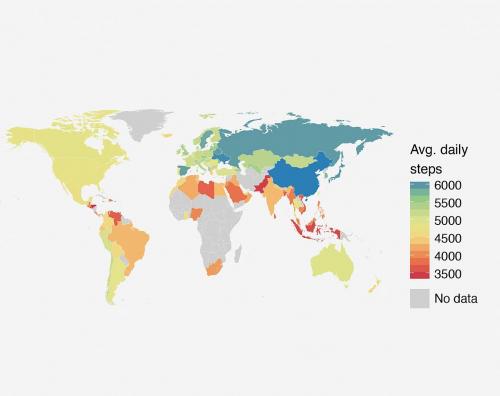NIH-funded team uses smartphone data in global study of physical activity
Large-scale study reveals targets for obesity prevention, wisdom of walkable communities.
Using a larger dataset than for any previous human movement study, National Institutes of Health-funded researchers at Stanford University in Palo Alto, California, have tracked physical activity by population for more than 100 countries. Their research follows on a recent estimate that more than 5 million people die each year from causes associated with inactivity.

The map show the most and least active countries
The large-scale study of daily step data from anonymous smartphone users dials in on how countries, genders, and community types fare in terms of physical activity and what results may mean for intervention efforts around physical activity and obesity.
Big data is not just about big numbers, but also the patterns that can explain important health trends,” said expert.
“Data science and modeling can be immensely powerful tools. They can aid in harnessing and analyzing all the personalized data that we get from our phones and wearable devices.”
Almost three quarters of adults in developed countries and half of adults in developing economies carry a smartphone. The devices are equipped with tiny accelerometers, computer chip that maintains the orientation of the screen, and can also automatically record stepping motions. The users whose data contributed to this study subscribed to the Azumio Argus app, a free application for tracking physical activity and other health behaviors.
In their study, the researchers analyzed 68 million days of minute-by-minute step recordings from 717,527 anonymous users of the smartphone app. Participation spanned 111 countries, but the researchers focused their study on 46 countries, each with at least 1,000 users. Of those, 90 percent of users were from 32 high income countries and 10 percent were from 14 middle income countries. The Stanford Mobilize Center is an NIH Big Data 2 Knowledge Center of Excellence.
“The study is 1,000 times larger than any previous study on human movement,” said expert. “There have been wonderful health surveys done, but our new study provides data from more countries, many more subjects, and tracks people’s activity on an ongoing basis in their free-living environments versus a survey in which you rely on people to self-report their activity. This opens the door to new ways of doing science at a much larger scale than we have been able to do before.”
In addition to the step records, the researchers accessed age, gender, and height and weight status of users who registered the smartphone app. They used the same calculation that economists use for income inequality — called the Gini index — to calculate activity inequality by country.
“These results reveal how much of a population is activity-rich, and how much of a population is activity-poor,” expert said. “In regions with high activity inequality there are many people who are activity poor, and activity inequality is a strong predictor of health outcomes.”
Globally, the average user recorded about 5,000 steps per day. The smartphone data reflected the degree of difference, or inequality, for activity among people within a given country. By comparing countries with more uniform activity patterns and those with unequal activity, certain patterns and health dynamics emerged. For instance, countries with the greatest activity inequality are also the countries with the greatest obesity problem. Individuals in the five countries with the greatest activity inequality are nearly 200 percent more likely to be obese than individuals from the five countries with the lowest activity inequality.
The average activity — measured in steps counted by smartphone accelerometer — is equivalent for people in the United States and Mexico, for example. But individuals in the United States reflect a wider range of activity levels than those in Mexico. This wider gap between active and sedentary people corresponds with higher prevalence of obesity in the United States overall.
Source: U.S. National Institutes of Health
- 396 reads
Human Rights
Ringing FOWPAL’s Peace Bell for the World:Nobel Peace Prize Laureates’ Visions and Actions

Protecting the World’s Cultural Diversity for a Sustainable Future

The Peace Bell Resonates at the 27th Eurasian Economic Summit

Declaration of World Day of the Power of Hope Endorsed by People in 158 Nations

Puppet Show I International Friendship Day 2020

